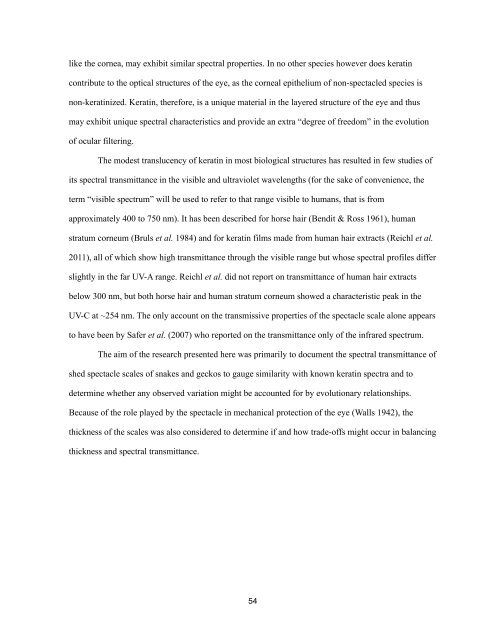Chapter 1, The Reptilian Spectacle - UWSpace - University of ...
Chapter 1, The Reptilian Spectacle - UWSpace - University of ...
Chapter 1, The Reptilian Spectacle - UWSpace - University of ...
You also want an ePaper? Increase the reach of your titles
YUMPU automatically turns print PDFs into web optimized ePapers that Google loves.
like the cornea, may exhibit similar spectral properties. In no other species however does keratin<br />
contribute to the optical structures <strong>of</strong> the eye, as the corneal epithelium <strong>of</strong> non-spectacled species is<br />
non-keratinized. Keratin, therefore, is a unique material in the layered structure <strong>of</strong> the eye and thus<br />
may exhibit unique spectral characteristics and provide an extra “degree <strong>of</strong> freedom” in the evolution<br />
<strong>of</strong> ocular filtering.<br />
<strong>The</strong> modest translucency <strong>of</strong> keratin in most biological structures has resulted in few studies <strong>of</strong><br />
its spectral transmittance in the visible and ultraviolet wavelengths (for the sake <strong>of</strong> convenience, the<br />
term “visible spectrum” will be used to refer to that range visible to humans, that is from<br />
approximately 400 to 750 nm). It has been described for horse hair (Bendit & Ross 1961), human<br />
stratum corneum (Bruls et al. 1984) and for keratin films made from human hair extracts (Reichl et al.<br />
2011), all <strong>of</strong> which show high transmittance through the visible range but whose spectral pr<strong>of</strong>iles differ<br />
slightly in the far UV-A range. Reichl et al. did not report on transmittance <strong>of</strong> human hair extracts<br />
below 300 nm, but both horse hair and human stratum corneum showed a characteristic peak in the<br />
UV-C at ~254 nm. <strong>The</strong> only account on the transmissive properties <strong>of</strong> the spectacle scale alone appears<br />
to have been by Safer et al. (2007) who reported on the transmittance only <strong>of</strong> the infrared spectrum.<br />
<strong>The</strong> aim <strong>of</strong> the research presented here was primarily to document the spectral transmittance <strong>of</strong><br />
shed spectacle scales <strong>of</strong> snakes and geckos to gauge similarity with known keratin spectra and to<br />
determine whether any observed variation might be accounted for by evolutionary relationships.<br />
Because <strong>of</strong> the role played by the spectacle in mechanical protection <strong>of</strong> the eye (Walls 1942), the<br />
thickness <strong>of</strong> the scales was also considered to determine if and how trade-<strong>of</strong>fs might occur in balancing<br />
thickness and spectral transmittance.<br />
54
















